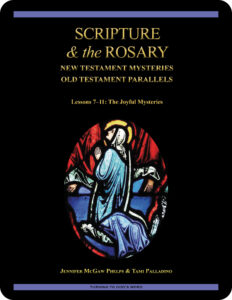 Scripture & the Rosary:
Scripture & the Rosary:
New Testament Mysteries,
Old Testament Parallels
The First Joyful Mystery
Lesson 7 The Angel Gabriel Was Sent to a Virgin
the Gospel According to Luke 1:26–35
the First Book of Samuel 1:9–17
Revised Standard Version Catholic Edition (RSVCE)*
New American Bible Revised Edition (NABRE)*
Catechism of the Catholic Church
Rosarium Virginis Mariae (Rosary of the Virgin Mary)
ex libris (in our library)
cross references for Scripture & the Rosary
glossary for Scripture & the Rosary
next lesson: Mary Arose & Went with Haste
This material coordinates with Lesson 7 on pages 24–27 in Scripture & the Rosary: New Testament Mysteries, Old Testament Parallels.
And Mary said, “My soul magnifies the Lord, and my spirit rejoices in God my Savior,
for he has regarded the low estate of his handmaiden.
For behold, henceforth all generations will call me blessed;
for he who is mighty has done great things for me, and holy is his name.”
—the Gospel According to Luke 1:46–49
welcome to our in-depth study of Scripture & the Rosary
We invite groups and individuals to become acquainted with Turning to God’s Word Catholic Bible  studies through
studies through  Scripture & the Rosary: New Testament Mysteries, Old Testament Parallels, which has been granted an imprimatur. Although no longer available in print, the first six lessons can be downloaded from our website. The remaining 20 lessons are posted throughout the liturgical year along with their related online study pages. Click here to access Lesson 7 through Lesson 11. If you have a Bible-related question or comment, you can contact our authors using one of the “ask us your question” or “what do you think” buttons on any online study page.
Scripture & the Rosary: New Testament Mysteries, Old Testament Parallels, which has been granted an imprimatur. Although no longer available in print, the first six lessons can be downloaded from our website. The remaining 20 lessons are posted throughout the liturgical year along with their related online study pages. Click here to access Lesson 7 through Lesson 11. If you have a Bible-related question or comment, you can contact our authors using one of the “ask us your question” or “what do you think” buttons on any online study page.
open with prayer
It’s always wise to begin any Bible study with prayer, whether reading the Scriptures alone or meeting with others in a discussion group. You can pray using your own words or use one of the opening prayers on our website. We especially like the following:
Lord Jesus, you promised to send your Holy Spirit to teach us all things.
As we read and study your word today,
allow it to touch our hearts and change our lives. Amen.
let’s begin with what it means to be joyful
The following reflection is from an early Lost in Translation entry written by Turning to God’s Word author Matthew Phelps, who has a broad background in classical languages. Although there are no videos with Scripture & the Rosary: New Testament Mysteries, Old Testament Parallels, most of our other Turning to God’s World studies have free videos with each lesson. You can access these from the supplemental study pages, which are linked on the study directories under TtGW studies in the drop-down menu at the top of the website.
“In the Gospel According to John 15:9–17, Jesus makes an unusual promise of joy to those who follow his commandments. In New Testament language, love and peace are much more common positive outcomes of following Jesus. What is the meaning of joy in the Christian sense? How might Christian joy differ from happiness? Is it likely that joy is something Jesus’ first disciples would have understood and wanted?
The Greek word translated as joy is χαρά (chara) and has a fairly straightforward meaning of “delight.” What makes this word chara interesting is that it shares a common root with the word χάρις (charis), which is the Greek word for grace. What this connection suggests is that in the New Testament there’s a strong connection between joy and grace. That connection between these two concepts is lost in translations into English.”
 ? What do you think constitutes grace?
? What do you think constitutes grace?
? In what ways might the concept of joy and grace be brought together in Jesus Christ?
? How might joy and grace be connected in your own spiritual life?
? Consider whether spiritual joy is something that you value.
? Do you think your attitude toward spiritual joy is something others can see?
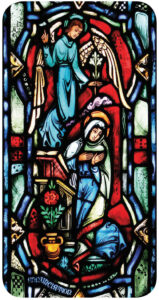 making connections—two joyful annunciations
making connections—two joyful annunciations
One purpose of Scripture & the Rosary: New Testament Mysteries, Old Testament Parallels is to point to ways Old Testament events foreshadow key moments in the lives of Jesus and the Blessed Virgin Mary. This begins in earnest in Lesson 7, which introduces the first of the Joyful Mysteries, the Annunciation. Clicking on the New and Old Testament stained glass windows will enlarge the art. The same art illustrates Lesson 7 in Scripture & the Rosary: New Testament Mysteries, Old Testament Parallels.
let’s look at the new in the light of the old
As you read through this lesson’s selected passages from the New and Old Testaments, ask yourself what these two biblical accounts have in common. Additional in-depth questions can be found  on pages 24–27 in Scripture & the Rosary: New Testament Mysteries, Old Testament Parallels. You can learn more about Samuel’s birth and early life in Lesson 1 The LORD Announces He Is About to Do a New Thing in the Turning to God’s Word Catholic Bible study Thus Says the LORD: God Speaks Through His Servants the Prophets—Volume I: A Kingdom Divided.
on pages 24–27 in Scripture & the Rosary: New Testament Mysteries, Old Testament Parallels. You can learn more about Samuel’s birth and early life in Lesson 1 The LORD Announces He Is About to Do a New Thing in the Turning to God’s Word Catholic Bible study Thus Says the LORD: God Speaks Through His Servants the Prophets—Volume I: A Kingdom Divided.
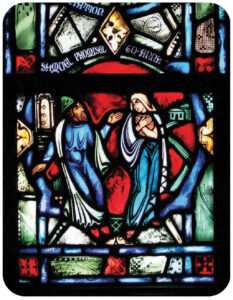 ? What is the meaning of the word annunciation?
? What is the meaning of the word annunciation?
? What kind of annunciation is Hannah receiving, and from whom?
? Compare what Hannah is told by the priest Eli with what the Blessed Virgin Mary is told by the angel Gabriel at the Annunciation. How are the two women’s situations different?
? Do Hannah and Mary react in similar or different ways? For additional insight see the magisterial quote “Victory of Hope” on page 26 in Scripture & the Rosary: New Testament Mysteries, Old Testament Parallels.
? How is God active in both biblical accounts?
 ? Which verses in the Old Testament account can be interpreted as pointing ahead to the promise of a Messiah?
? Which verses in the Old Testament account can be interpreted as pointing ahead to the promise of a Messiah?
? Look at the pictures of the stained glass window on pages 24 and 26 in Scripture & the Rosary: New Testament Mysteries, Old Testament Parallels. What similarities can be seen between these depictions of the New and Old Testament scenes?
supplemental Scripture
The lessons about the Joyful Mysteries will culminate with Lesson 11 All Who Heard Him Were Amazed, The First Joyful Mystery is the Annunciation. The New Testament text is taken from the Gospel According to Luke 1:26–35. This  recounting of the angel Gabriel’s appearance to the Blessed Virgin Mary includes information that Mary is “full of grace,” a description emphasized in the Rosary prayers. The Old Testament parallel is the story of Hannah learning from the priest Eli that she soon will bear a child. Old Testament parallels to the Joyful Mysteries are taken from the First Book of Samuel 1:9–17. Samuel is honored by the Church as the last of the Old Testament judges and the first to hold the office of prophet as one sent to counsel those anointed as kings over God’s chosen people. You can learn
recounting of the angel Gabriel’s appearance to the Blessed Virgin Mary includes information that Mary is “full of grace,” a description emphasized in the Rosary prayers. The Old Testament parallel is the story of Hannah learning from the priest Eli that she soon will bear a child. Old Testament parallels to the Joyful Mysteries are taken from the First Book of Samuel 1:9–17. Samuel is honored by the Church as the last of the Old Testament judges and the first to hold the office of prophet as one sent to counsel those anointed as kings over God’s chosen people. You can learn  more about Samuel’s life as a prophet in the Turning to God’s Word Catholic Bible study The United Kingdom: Saul, David & Samuel Foreshadow Christ the King. The First Book of Samuel 1:1–18 covers the essential points in Lesson 7 in Scripture & the Rosary: New Testament Mysteries, Old Testament Parallels. The Book of Judges provides additional background about the Old Testament judges and the world in which they lived.
more about Samuel’s life as a prophet in the Turning to God’s Word Catholic Bible study The United Kingdom: Saul, David & Samuel Foreshadow Christ the King. The First Book of Samuel 1:1–18 covers the essential points in Lesson 7 in Scripture & the Rosary: New Testament Mysteries, Old Testament Parallels. The Book of Judges provides additional background about the Old Testament judges and the world in which they lived.
a connection to the Angelus
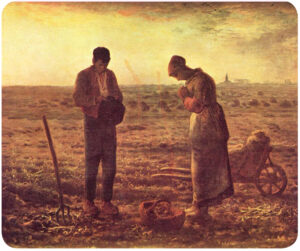 Angelus Domini is a Marian prayer based on the scriptural account of the Annunciation. Although most of the content of this prayer comes from the Gospel According to Luke, the key phrase—”the Word became flesh and dwelt among us”—is taken from the Gospel According to John 1:14. This firmly focuses the prayer on the Incarnation, one of the two foundational theological beliefs of Christianity. (The second foundation Christian belief is the Resurrection.) The history of the Angelus, which developed in European monasteries, dates at least to the 1300s. The Angelus bell traditionally is rung at the beginning of the day, at noon, and again in the evening—the three times when the Angelus is prayed. Find other prayers to the Blessed Virgin on our
Angelus Domini is a Marian prayer based on the scriptural account of the Annunciation. Although most of the content of this prayer comes from the Gospel According to Luke, the key phrase—”the Word became flesh and dwelt among us”—is taken from the Gospel According to John 1:14. This firmly focuses the prayer on the Incarnation, one of the two foundational theological beliefs of Christianity. (The second foundation Christian belief is the Resurrection.) The history of the Angelus, which developed in European monasteries, dates at least to the 1300s. The Angelus bell traditionally is rung at the beginning of the day, at noon, and again in the evening—the three times when the Angelus is prayed. Find other prayers to the Blessed Virgin on our  page of traditional Marian prayers. Learn more about Jesus as the Word of God in Lesson 1 In the Beginning Was the Word in the Turning to God’s Word Catholic Bible study The Gospel According to John: An Encounter with Grace & Truth.
page of traditional Marian prayers. Learn more about Jesus as the Word of God in Lesson 1 In the Beginning Was the Word in the Turning to God’s Word Catholic Bible study The Gospel According to John: An Encounter with Grace & Truth.
biblical vocabulary—what are these mysteries?
The word mystery can be misleading. We’re all familiar with the type of mystery that Sherlock Holmes might be called in to solve, but that meaning doesn’t apply to the Mysteries of the Rosary or to other mysteries of our faith. When used in a religious sense, mystery refers to a religious truth that one can approach only by divine revelation. One catechist we know describes religious mystery not as a puzzle to be solved, but as something Christians are expected to ponder or think about.
ex libris—find out what’s behind all those Marian feasts
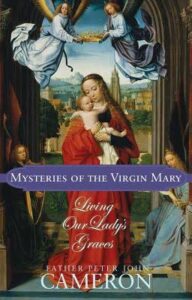 Mysteries of the Virgin Mary approaches the task of increasing understanding of the theology behind Marian doctrine by looking at reasons behind Marian
Mysteries of the Virgin Mary approaches the task of increasing understanding of the theology behind Marian doctrine by looking at reasons behind Marian  feasts throughout the liturgical year. Chapters cover the Birth of Mary, her Presentation, her Immaculate Heart, her Holy Name, and her role as Queen of Heaven, as well as her titles as Our Lady of Sorrows, Our Lady of Guadalupe, and, of course, Our Lady of the Rosary. Read excerpts and learn more about Mysteries of the Virgin Mary and other works related to Bible study at ex libris—main bookshelf.
feasts throughout the liturgical year. Chapters cover the Birth of Mary, her Presentation, her Immaculate Heart, her Holy Name, and her role as Queen of Heaven, as well as her titles as Our Lady of Sorrows, Our Lady of Guadalupe, and, of course, Our Lady of the Rosary. Read excerpts and learn more about Mysteries of the Virgin Mary and other works related to Bible study at ex libris—main bookshelf.
WHAT DO YOU THINK that God has planned for your life?
Archbishop Salvatore Rino Fisichella, a member of the Roman Curia, explains religious mystery in terms of the hidden plan God has for each person. This begins to unfold when we experience authentic encounter with the risen Jesus. This is the big payoff of Christianity, and was one of the favorite themes of Pope St. John Paul II. In learning who Christ is, we learn important truths about who we are as well.
? How might meditating on the Mysteries of the Rosary increase your understanding about major events in Jesus’ life?
 ? What might explain why the Church traditionally connects such meditation to prayer?
? What might explain why the Church traditionally connects such meditation to prayer?
? What is the primary way in which you nurture your relationship with Jesus?
? How can religious encounter provide valuable insight about individual Christians and what purpose God has intended for each of us?
ex libris—a book that makes a great Advent companion
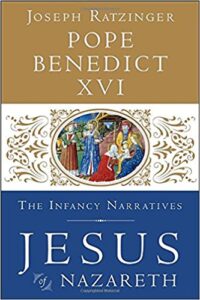
 Jesus of Nazareth: The Infancy Narratives is the last book in a three-part series by Pope Benedict XVI about Jesus in the Gospels. Focusing on Scripture, this relatively short work examines the infancy narratives found in the Gospels According to Matthew and Luke, and when relevant looks at the Gospel According to John. Read excerpts and learn more about the Jesus of Nazareth trilogy and other works related to Bible study at ex libris—main bookshelf.
Jesus of Nazareth: The Infancy Narratives is the last book in a three-part series by Pope Benedict XVI about Jesus in the Gospels. Focusing on Scripture, this relatively short work examines the infancy narratives found in the Gospels According to Matthew and Luke, and when relevant looks at the Gospel According to John. Read excerpts and learn more about the Jesus of Nazareth trilogy and other works related to Bible study at ex libris—main bookshelf.
“…[T]he question arises: how did Matthew and Luke come to know the story that they recount? What are their sources? As Joachim Gnilka rightly says, it is evidently a matter of  family traditions. Luke indicates from time to time that Mary, the Mother of Jesus, is herself one of his sources, especially when he says [in the Gospel According to Luke 2:19 and 2:51] that “his mother kept all these things in her heart.” Only she could report the event of the annunciation, for which there were no human witnesses.
family traditions. Luke indicates from time to time that Mary, the Mother of Jesus, is herself one of his sources, especially when he says [in the Gospel According to Luke 2:19 and 2:51] that “his mother kept all these things in her heart.” Only she could report the event of the annunciation, for which there were no human witnesses.
“Naturally, modern “critical” exegesis will tend to dismiss such connections as naive. But why should there not have been a tradition of this kind, preserved in the most intimate circle and theologically elaborated at the same time? Why should Luke have invented the statement about Mary keeping the words and events in her heart, if there were no concrete grounds for saying so?”
 parthenos—you could look it up in our archives
parthenos—you could look it up in our archives
The biblical text for Lesson 7—The Angel Gabriel Was Sent to a Virgin—contains strong evidence to support Catholic teaching regarding the virginity of Jesus’ Mother. Can you tell what it is? Read parthenos in Lost in Translation, an online column in which Turning to God’s Word author Matthew Phelps helps readers connect with ideas expressed in the original languages of the Scriptures. New Lost in Translation entries are posted on Mondays, and past entries  are archived on our website. Contact us if you’d like to receive Lost in Translation by email every week. You can learn more about important Messianic prophecy in the Old Testament in Lesson 20 Isaiah Foresees Immanuel’s Birth in the Turning to God’s Word Catholic Bible study Thus Says the LORD: God Speaks Through His Servants the Prophets—Volume I: A Kingdom Divided.
are archived on our website. Contact us if you’d like to receive Lost in Translation by email every week. You can learn more about important Messianic prophecy in the Old Testament in Lesson 20 Isaiah Foresees Immanuel’s Birth in the Turning to God’s Word Catholic Bible study Thus Says the LORD: God Speaks Through His Servants the Prophets—Volume I: A Kingdom Divided.
do you know the spiritual fruit associated with the First Joyful Mystery?
Hint: It’s best modeled by the Blessed Virgin Mary and her Son. You can find out what it is in the “Fruits of Prayer” box on page 25 in Scripture & the Rosary: New Testament Mysteries, Old Testament Parallels. In what ways might this fruit benefit you in your everyday life?
visual meditation is a form of prayer
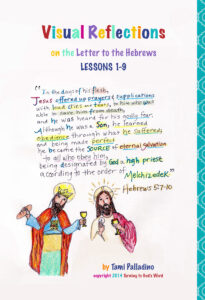 If you like to draw, consider illustrating your prayers for Scripture & the Rosary: New Testament Mysteries, Old Testament Parallels. Check out the visual-meditation journal
If you like to draw, consider illustrating your prayers for Scripture & the Rosary: New Testament Mysteries, Old Testament Parallels. Check out the visual-meditation journal  that Turning to God’s Word co-founder Tami Palladino created for The Letter to the Hebrews: An Explanation of the Mechanism of Our Salvation. Tami also illustrated Sing a New Psalm: Communicating with God Through the Prayers of the Church—Volume I: Lauds & Vespers and The Revelation of Jesus Christ: The Faithful Witness, and some lessons in You Shall Have No Other Gods: The Book of Exodus and In the Beginning: The Book of Genesis.
that Turning to God’s Word co-founder Tami Palladino created for The Letter to the Hebrews: An Explanation of the Mechanism of Our Salvation. Tami also illustrated Sing a New Psalm: Communicating with God Through the Prayers of the Church—Volume I: Lauds & Vespers and The Revelation of Jesus Christ: The Faithful Witness, and some lessons in You Shall Have No Other Gods: The Book of Exodus and In the Beginning: The Book of Genesis.
the best Catholic commentary about Scripture
 To find out more about how Church teaching is supported by passages in Scripture & the Rosary: New Tetament Mysteries, Old Testament Parallels, check out the Index of Citations in the Catechism of the Catholic Church. Links to the primary Scripture passages in the lesson (Revised Standard Version Catholic Edition [RSVCE*]) and relevant paragraphs in the Catechism are provided here. Not every passage in the biblical text for this study is referenced in a Catechism paragraph, however.
To find out more about how Church teaching is supported by passages in Scripture & the Rosary: New Tetament Mysteries, Old Testament Parallels, check out the Index of Citations in the Catechism of the Catholic Church. Links to the primary Scripture passages in the lesson (Revised Standard Version Catholic Edition [RSVCE*]) and relevant paragraphs in the Catechism are provided here. Not every passage in the biblical text for this study is referenced in a Catechism paragraph, however.
the Gospel According to Luke 1:26—paragraph 332
the Gospel According to Luke 1:26–27—paragraph 488
the Gospel According to Luke 1:26–38—paragraphs 497, 706, 723, 2571
the Gospel According to Luke 1:28—paragraphs 490, 491
the Gospel According to Luke 1:28–37—paragraph 494
the Gospel According to Luke 1:31—paragraphs 430, 2812
the Gospel According to Luke 1:32—paragraph 559
the Gospel According to Luke 1:32–33—paragraph 709
the Gospel According to Luke 1:34—paragraphs 484, 497, 505
the Gospel According to Luke 1:35—paragraphs 437, 484, 486
the First Book of Samuel 1:1–28—paragraph 489
the First Book of Samuel 1:9–18—paragraph 2578
ways our glossary might prove helpful
In addition to providing extra information about geographical locations, our glossary also points out  when a person or place is mentioned in the biblical text under more than one name or more than one spelling. If you can remember a name but aren’t sure in which lesson it shows up, you can find it in the glossary, which lists every proper noun that appears in the primary biblical text in Scripture & the Rosary: New Testament Mysteries, Old Testament Parallels.
when a person or place is mentioned in the biblical text under more than one name or more than one spelling. If you can remember a name but aren’t sure in which lesson it shows up, you can find it in the glossary, which lists every proper noun that appears in the primary biblical text in Scripture & the Rosary: New Testament Mysteries, Old Testament Parallels.
to learn more, read more Scripture
When you’re having difficulty understanding a passage of Scripture, it can help to read the  cross references—but looking these up takes time. We’ve compiled the cross references from the Revised Standard Version Second Catholic Edition (RSV2CE)—the same translation that we reprint in our study books. The list can be found at the top of every online study page, and it includes links to cross references in the primary biblical texts for all of the lessons in Scripture & the Rosary: New Testament Mysteries, Old Testament Parallels.
cross references—but looking these up takes time. We’ve compiled the cross references from the Revised Standard Version Second Catholic Edition (RSV2CE)—the same translation that we reprint in our study books. The list can be found at the top of every online study page, and it includes links to cross references in the primary biblical texts for all of the lessons in Scripture & the Rosary: New Testament Mysteries, Old Testament Parallels.
don’t forget about our indexes & extra online material

 If you’re trying to locate information about a Scripture passage, you can look it up in the index at the back of the online version of this study. If you want to revisit a commentary, you can look it up by title in the topics index. If you want to learn more about another book of the Bible for which there’s a Turning to God’s Word study, you can read online commentaries and watch any accompanying videos by choosing a lesson from one of the study directories. (There are no lesson videos with Scripture & the Rosary: New Testament Mysteries, Old Testament Parallels.) Finally, if you have a question or would like to make a comment about any of our studies, you can use the “ask us your question” or “what do you think” button to email our authors.
If you’re trying to locate information about a Scripture passage, you can look it up in the index at the back of the online version of this study. If you want to revisit a commentary, you can look it up by title in the topics index. If you want to learn more about another book of the Bible for which there’s a Turning to God’s Word study, you can read online commentaries and watch any accompanying videos by choosing a lesson from one of the study directories. (There are no lesson videos with Scripture & the Rosary: New Testament Mysteries, Old Testament Parallels.) Finally, if you have a question or would like to make a comment about any of our studies, you can use the “ask us your question” or “what do you think” button to email our authors.
ex libris—Church documents & books about religious topics
Link to magisterial documents referred to in our Bible studies at ex libris—magisterial documents.  This listing includes significant recent encyclicals as well as a number of historical Church documents. Recommended books related to Scripture study can be found at ex libris—main bookshelf.
This listing includes significant recent encyclicals as well as a number of historical Church documents. Recommended books related to Scripture study can be found at ex libris—main bookshelf.
memorize a favorite Bible verse (4:48)
Turning to God’s Word co-founder Tami Palladino has created a short video about the benefits of memorizing Bible verses. Choosing a passage that you find particularly meaningful will make the task easier. There are inspiring verses in every book of the Bible, but some people in our Turning to God’s Word Catholic Bible studies like to memorize a verse from their lesson every week. For more ideas and helps tips, check out Tami’s video, Why Memorize Scripture? It’s less than five minutes long.
wondering how to pronounce some of these words?
The following links are to readings from the New International Version (NIV) Bible. To listen, click on the audio icon above the printed text. Although not taken from the translations used in our study materials, the NIV readings provide an audio guide to pronunciation of words in this lesson’s primary biblical texts. A close online version of the translation of the Bible used in Catholic liturgy in the United States as well as an audio guide for daily Mass readings for the current month can be found on the website of the United States Conference of Catholic Bishops (USCCB).
the Gospel According to Luke 1:26–35 (NIV)
the First Book of Samuel 1:9–17 (NIV)
close by praying the First Joyful Mystery
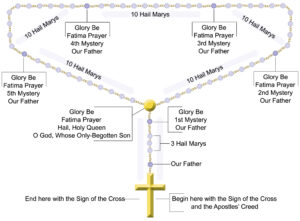 Many of our study groups like to conclude discussions of Scripture & the Rosary: New Testament Mysteries, Old Testament Parallels by praying a decade of the Rosary devoted to the Mystery that’s the focus of their lesson. A number of Catholics include a request for an increase in the spiritual fruit associated with the mystery. You can find out what’s associated with the First Joyful Mystery in the “Fruits of Prayer” box on page 25 in Scripture & the Rosary: New Testament Mysteries, Old Testament Parallels.
Many of our study groups like to conclude discussions of Scripture & the Rosary: New Testament Mysteries, Old Testament Parallels by praying a decade of the Rosary devoted to the Mystery that’s the focus of their lesson. A number of Catholics include a request for an increase in the spiritual fruit associated with the mystery. You can find out what’s associated with the First Joyful Mystery in the “Fruits of Prayer” box on page 25 in Scripture & the Rosary: New Testament Mysteries, Old Testament Parallels.
 We invite you to pray along with Turning to God’s Word co-founder Tami Palladino and her daughter Anne Marie on their video featuring the First Joyful Mystery of the Rosary. The prayers and videos for all 20 mysteries are accessible year-round at how to pray the Rosary, and you can access a link to Tami and Anne Marie’s how-to video to learn what’s important about praying the Rosary. Clicking on the diagram (above) will take you to the website page with the Rosary prayers.
We invite you to pray along with Turning to God’s Word co-founder Tami Palladino and her daughter Anne Marie on their video featuring the First Joyful Mystery of the Rosary. The prayers and videos for all 20 mysteries are accessible year-round at how to pray the Rosary, and you can access a link to Tami and Anne Marie’s how-to video to learn what’s important about praying the Rosary. Clicking on the diagram (above) will take you to the website page with the Rosary prayers.
Lesson 8 Mary Arose & Went with Haste (the Second Joyful Mystery, the Visitation of Mary to Elizabeth)—the Gospel According to Luke 1:39–57 and the First Book of Samuel 2:1–9
Lesson 6 The Holy Spirit: Sanctification & Love—the First Letter of Paul to the Corinthians 13:1–10, the First Letter of Paul to the Corinthians 13:12–13, and the book of Genesis 46:26–30
you also may like our two-part study of the prophets
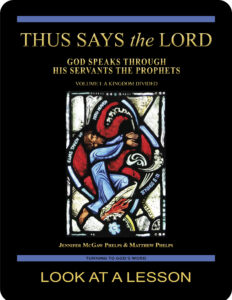
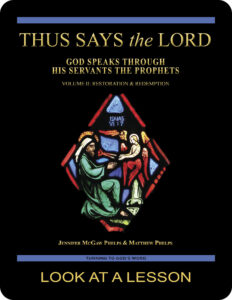 Thus Says the LORD: God Speaks Through His Servants the Prophets—Volume I: A Kingdom Divided examines the prophets in their historical context using the First and Second Books of the Kings and other Old Testament passages written before the Babylonian Exile in 586 B.C. Volume II: Restoration & Redemption looks at the post-exilic prophets. This 51-lesson Catholic Bible study builds on The United Kingdom of Israel: Saul, David & Solomon Foreshadow Christ the King. Click on the books’ covers to view a sample lesson from each volume.
Thus Says the LORD: God Speaks Through His Servants the Prophets—Volume I: A Kingdom Divided examines the prophets in their historical context using the First and Second Books of the Kings and other Old Testament passages written before the Babylonian Exile in 586 B.C. Volume II: Restoration & Redemption looks at the post-exilic prophets. This 51-lesson Catholic Bible study builds on The United Kingdom of Israel: Saul, David & Solomon Foreshadow Christ the King. Click on the books’ covers to view a sample lesson from each volume.
start a Turning to God’s Word Bible study
Thank you for your interest in Scripture & the Rosary: New Testament Mysteries, Old Testament Parallels. 
 Information about beginning a Turning to God’s Word Bible study can be found at start a Bible study. Tami, Matthew, and I are available to answer your questions and to offer support. You may use this email to contact us directly if you’re interested in starting a Turning to God study or in having your study schedule listed with other TtGW study groups on our website. —Jennifer
Information about beginning a Turning to God’s Word Bible study can be found at start a Bible study. Tami, Matthew, and I are available to answer your questions and to offer support. You may use this email to contact us directly if you’re interested in starting a Turning to God study or in having your study schedule listed with other TtGW study groups on our website. —Jennifer
*There are seven deuterocanonical books in the Old Testament—the Books of Tobit, Judith, Wisdom, Sirach, Baruch, and First and Second Maccabees, as well as some passages in the Books of Esther and Daniel. Protestants usually refer to these works as “apocryphal,” a word that means “outside the (Protestant) canon” because they’re excluded from most Protestant Bibles. The word “deuterocanonical” means “second canon”; Catholics use that word to refer to any section of the Catholic Old Testament for which there are no extant, or existing, Hebrew manuscripts. All of the deuterocanonical books appear in the Septuagint, the earliest remaining versions of which date to the 1st century B.C. This Greek translation of the Old Testament was in common use by Jews at the time of Jesus. Learn more by reading How Do Catholic & Protestant Bibles Differ?
Turning to God’s Word printed Bible studies use the 2006 Revised Standard Version Second Catholic Edition (RSV2CE) translation for all Scripture references except those to the Psalms, which are taken from The Abbey Psalms and Canticles, prepared by the Benedictine monks of Conception Abbey and published in 2020 by the United States Conference of Catholic Bishops (USCCB). All Scripture links for the digital version of Scripture & the Rosary: New Testament Mysteries, Old Testament Parallels are to the 1966 Revised Standard Version Catholic Edition (RSVCE) translation. The New International Version (NIV) audio recordings follow the same chapter and verse numbering as the RSV Catholic translations, but the NIV translation doesn’t include the deuterocanonical books and passages.
The 1966 RSVCE uses archaic pronouns and verb forms such as “thee,” “thou,” “didst” in the Psalms and in direct quotations attributed to God. The 2006 RSV2CE replaces these with more accessible English. The few significant translation changes in the RSV2CE include rendering almah as “virgin” in the Book of Isaiah 7:14 and restoring the term “begotten” in the Gospel According to John 3:16.
Numbering varies for some passages in this Bible study. Turning to God’s Word studies follow the numbering in the Revised Standard Version Catholic translations (RSV2CE and RSVCE). Discrepancies in the New American Bible Revised Edition (NABRE) are noted in the Index of Scripture Citations.
 You can learn more about the Psalms by viewing a sample lesson from the Turning to God’s Word Catholic Bible study Sing a New Psalm: Communicating with God Through the Prayers of the Church—Volume I: Lauds & Vespers. The second part of that study, Sing a New Psalm: Communicating with God Through the Prayers of the Church—Volume II: Vigils, Day Prayer & Compline, is scheduled for publication in 2025. Some verse numbers may vary in different translations of the Psalms.
You can learn more about the Psalms by viewing a sample lesson from the Turning to God’s Word Catholic Bible study Sing a New Psalm: Communicating with God Through the Prayers of the Church—Volume I: Lauds & Vespers. The second part of that study, Sing a New Psalm: Communicating with God Through the Prayers of the Church—Volume II: Vigils, Day Prayer & Compline, is scheduled for publication in 2025. Some verse numbers may vary in different translations of the Psalms.
